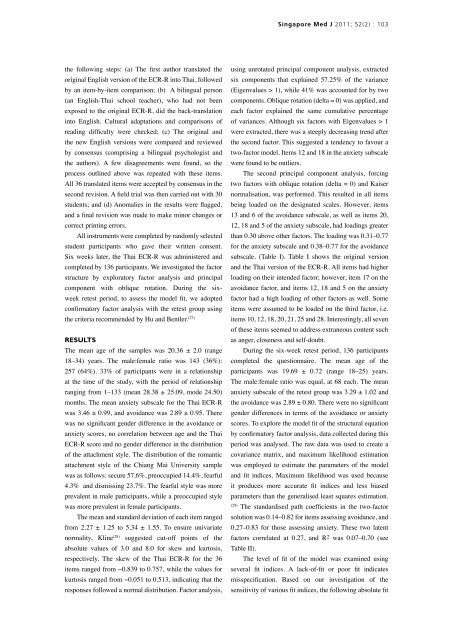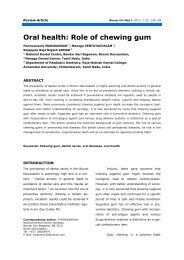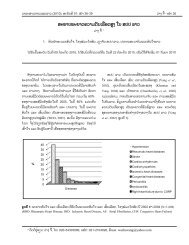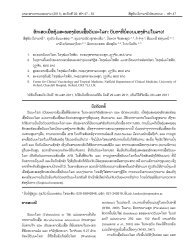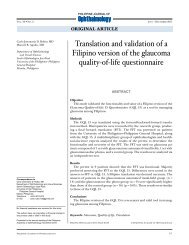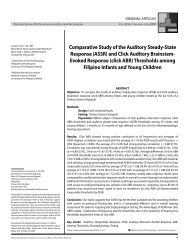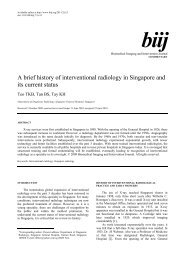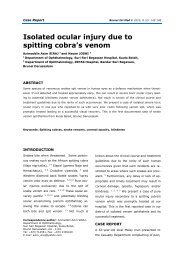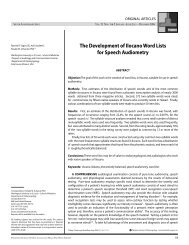Validity and reliability of the Thai version of the ... - ResearchGate
Validity and reliability of the Thai version of the ... - ResearchGate
Validity and reliability of the Thai version of the ... - ResearchGate
Create successful ePaper yourself
Turn your PDF publications into a flip-book with our unique Google optimized e-Paper software.
Singapore Med J 2011; 52(2) : 103<strong>the</strong> following steps: (a) The first author translated <strong>the</strong>original English <strong>version</strong> <strong>of</strong> <strong>the</strong> ECR-R into <strong>Thai</strong>, followedby an item-by-item comparison; (b) A bilingual person(an English-<strong>Thai</strong> school teacher), who had not beenexposed to <strong>the</strong> original ECR-R, did <strong>the</strong> back-translationinto English. Cultural adaptations <strong>and</strong> comparisons <strong>of</strong>reading difficulty were checked; (c) The original <strong>and</strong><strong>the</strong> new English <strong>version</strong>s were compared <strong>and</strong> reviewedby consensus (comprising a bilingual psychologist <strong>and</strong><strong>the</strong> authors). A few disagreements were found, so <strong>the</strong>process outlined above was repeated with <strong>the</strong>se items.All 36 translated items were accepted by consensus in <strong>the</strong>second revision. A field trial was <strong>the</strong>n carried out with 30students; <strong>and</strong> (d) Anomalies in <strong>the</strong> results were flagged,<strong>and</strong> a final revision was made to make minor changes orcorrect printing errors.All instruments were completed by r<strong>and</strong>omly selectedstudent participants who gave <strong>the</strong>ir written consent.Six weeks later, <strong>the</strong> <strong>Thai</strong> ECR-R was administered <strong>and</strong>completed by 136 participants. We investigated <strong>the</strong> factorstructure by exploratory factor analysis <strong>and</strong> principalcomponent with oblique rotation. During <strong>the</strong> sixweekretest period, to assess <strong>the</strong> model fit, we adoptedconfirmatory factor analysis with <strong>the</strong> retest group using<strong>the</strong> criteria recommended by Hu <strong>and</strong> Bentler. (27)RESULTSThe mean age <strong>of</strong> <strong>the</strong> samples was 20.36 ± 2.0 (range18–34) years. The male:female ratio was 143 (36%):257 (64%). 33% <strong>of</strong> participants were in a relationshipat <strong>the</strong> time <strong>of</strong> <strong>the</strong> study, with <strong>the</strong> period <strong>of</strong> relationshipranging from 1–133 (mean 28.38 ± 25.09, mode 24.50)months. The mean anxiety subscale for <strong>the</strong> <strong>Thai</strong> ECR-Rwas 3.46 ± 0.99, <strong>and</strong> avoidance was 2.89 ± 0.95. Therewas no significant gender difference in <strong>the</strong> avoidance oranxiety scores, no correlation between age <strong>and</strong> <strong>the</strong> <strong>Thai</strong>ECR-R score <strong>and</strong> no gender difference in <strong>the</strong> distribution<strong>of</strong> <strong>the</strong> attachment style. The distribution <strong>of</strong> <strong>the</strong> romanticattachment style <strong>of</strong> <strong>the</strong> Chiang Mai University samplewas as follows: secure 57.6%, preoccupied 14.4%, fearful4.3% <strong>and</strong> dismissing 23.7%. The fearful style was moreprevalent in male participants, while a preoccupied stylewas more prevalent in female participants.The mean <strong>and</strong> st<strong>and</strong>ard deviation <strong>of</strong> each item rangedfrom 2.27 ± 1.25 to 5.34 ± 1.55. To ensure univariatenormality, Kline (28) suggested cut-<strong>of</strong>f points <strong>of</strong> <strong>the</strong>absolute values <strong>of</strong> 3.0 <strong>and</strong> 8.0 for skew <strong>and</strong> kurtosis,respectively. The skew <strong>of</strong> <strong>the</strong> <strong>Thai</strong> ECR-R for <strong>the</strong> 36items ranged from −0.839 to 0.757, while <strong>the</strong> values forkurtosis ranged from −0.051 to 0.513, indicating that <strong>the</strong>responses followed a normal distribution. Factor analysis,using unrotated principal component analysis, extractedsix components that explained 57.25% <strong>of</strong> <strong>the</strong> variance(Eigenvalues > 1), while 41% was accounted for by twocomponents. Oblique rotation (delta = 0) was applied, <strong>and</strong>each factor explained <strong>the</strong> same cumulative percentage<strong>of</strong> variances. Although six factors with Eigenvalues > 1were extracted, <strong>the</strong>re was a steeply decreasing trend after<strong>the</strong> second factor. This suggested a tendency to favour atwo-factor model. Items 12 <strong>and</strong> 18 in <strong>the</strong> anxiety subscalewere found to be outliers.The second principal component analysis, forcingtwo factors with oblique rotation (delta = 0) <strong>and</strong> Kaisernormalisation, was performed. This resulted in all itemsbeing loaded on <strong>the</strong> designated scales. However, items13 <strong>and</strong> 6 <strong>of</strong> <strong>the</strong> avoidance subscale, as well as items 20,12, 18 <strong>and</strong> 5 <strong>of</strong> <strong>the</strong> anxiety subscale, had loadings greaterthan 0.30 above o<strong>the</strong>r factors. The loading was 0.31–0.77for <strong>the</strong> anxiety subscale <strong>and</strong> 0.38–0.77 for <strong>the</strong> avoidancesubscale. (Table I). Table I shows <strong>the</strong> original <strong>version</strong><strong>and</strong> <strong>the</strong> <strong>Thai</strong> <strong>version</strong> <strong>of</strong> <strong>the</strong> ECR-R. All items had higherloading on <strong>the</strong>ir intended factor; however, item 17 on <strong>the</strong>avoidance factor, <strong>and</strong> items 12, 18 <strong>and</strong> 5 on <strong>the</strong> anxietyfactor had a high loading <strong>of</strong> o<strong>the</strong>r factors as well. Someitems were assumed to be loaded on <strong>the</strong> third factor, i.e.items 10, 12, 18, 20, 21, 25 <strong>and</strong> 28. Interestingly, all seven<strong>of</strong> <strong>the</strong>se items seemed to address extraneous content suchas anger, closeness <strong>and</strong> self-doubt.During <strong>the</strong> six-week retest period, 136 participantscompleted <strong>the</strong> questionnaire. The mean age <strong>of</strong> <strong>the</strong>participants was 19.69 ± 0.72 (range 18–25) years.The male:female ratio was equal, at 68 each. The meananxiety subscale <strong>of</strong> <strong>the</strong> retest group was 3.29 ± 1.02 <strong>and</strong><strong>the</strong> avoidance was 2.89 ± 0.80. There were no significantgender differences in terms <strong>of</strong> <strong>the</strong> avoidance or anxietyscores. To explore <strong>the</strong> model fit <strong>of</strong> <strong>the</strong> structural equationby confirmatory factor analysis, data collected during thisperiod was analysed. The raw data was used to create acovariance matrix, <strong>and</strong> maximum likelihood estimationwas employed to estimate <strong>the</strong> parameters <strong>of</strong> <strong>the</strong> model<strong>and</strong> fit indices. Maximum likelihood was used becauseit produces more accurate fit indices <strong>and</strong> less biasedparameters than <strong>the</strong> generalised least squares estimation.(29)The st<strong>and</strong>ardised path coefficients in <strong>the</strong> two-factorsolution was 0.14–0.82 for items assessing avoidance, <strong>and</strong>0.27–0.83 for those assessing anxiety. These two latentfactors correlated at 0.27, <strong>and</strong> R 2 was 0.07–0.70 (seeTable II).The level <strong>of</strong> fit <strong>of</strong> <strong>the</strong> model was examined usingseveral fit indices. A lack-<strong>of</strong>-fit or poor fit indicatesmisspecification. Based on our investigation <strong>of</strong> <strong>the</strong>sensitivity <strong>of</strong> various fit indices, <strong>the</strong> following absolute fit


